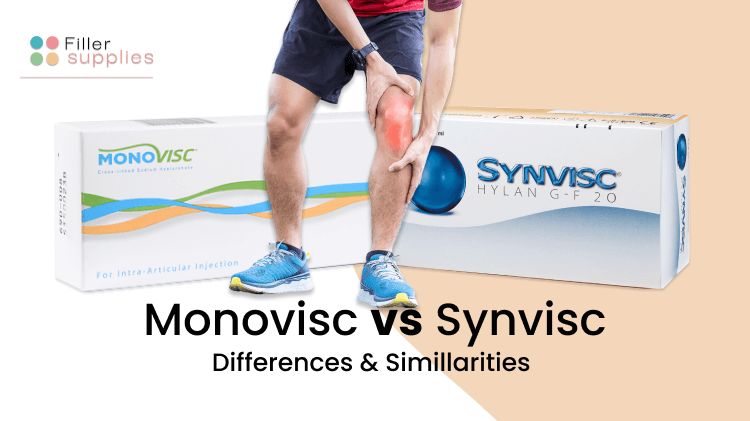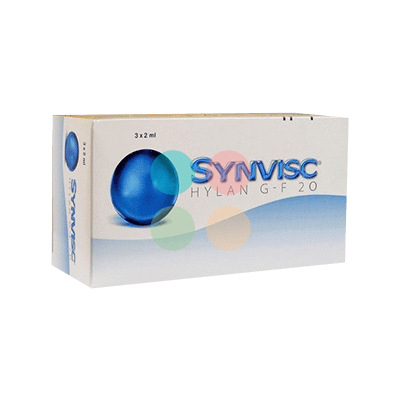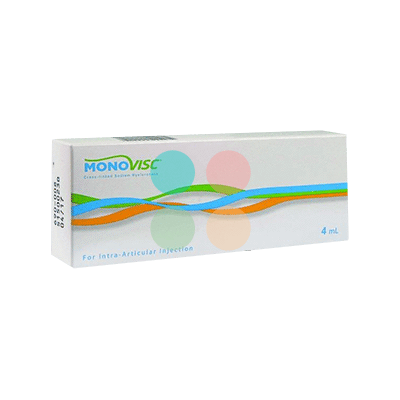Monovisc vs Synvisc. What is Similar and What is Different?

Knee osteoarthritis – the problem more and more adults have to deal with nowadays. This degenerative, multifactorial condition appears when the cartilage placed between the ends of the bones wears down; as a result, a person can have trouble walking, going up the stairs, or even standing. This health issue tends to get worse with age, so it is better to start treatment as soon as this problem appears.
Thankfully, there are some methods that can be used for the solution of this issue. We are talking about hyaluronic acid-based fillers -Monovisc and Synvisc. When used together with a proper physical therapy and exercise program, it becomes a real pain relief to people. In more severe cases, orthopedic fillers should be applied after removing overabundance joint fluid. And if you among those who didn’t even know about the existence of Synvisc and Monovisc injection – we prepared this article to tell all the needed information in more detail.
The purpose of orthopedic fillers
Orthopedic injections and therapy are very effective methods of eliminating painful sensations caused by such health issues as rheumatoid and osteoarthritis, as well as various sports injuries. Those can be used in combination with pain medications, thus provide immediate or permanent reaction. In his way, it is possible to avoid surgery for some time and make everyday routine much easier on a patient.
There are four types of orthopedic injections: ani-inflammatory, viscosupplementation, platelet-rich plasma (PRP), and stem cell injections.
- Anti-inflammatory injection – mainly cortisone or steroid shots that are meant for eliminating pain and inflammation processes in a specific area (joint or tendon);
- Viscosupplementation injection – these are hyaluronic-acid-based products in a gel form. These are administered directly into the joint and are usually prescribed for those with osteoarthritis knee pain to make motion much easier;
- Platelet-rich plasma (PRP) injections – these are made of the patient’s platelets for curing joints, tendons, and tissues that were injured;
- Stem cell injections – a patient’s stem cells taken from bone marrow in the pelvis or hip bone. Those are regenerative and can help rebuild soft tissue, cartilage, and bones.
Synvisc vs. Monovisc. What do they have in common?
 |
 |
| $329 | $339 |
 |
 |
| $349 | $249 |
Monovisc and Synvisc – two brands that are used the most often for osteoarthritis of the knee. Any treatment that involves these two products should always be conducted by licensed professionals in a specialized clinic. These viscosupplement medications have a lot in common (that is why they are often compared with each other), and we would like to discuss this topic in more detail.
- The active ingredient in their base. Medications contain naturally occurring hyaluronic acid in their base;
- Working principle. These medications are able to mimic the physiology and the acting of synovial fluid – lubricate the area between the bones, reduce unpleasant sensations;
- Administration technique. Monovisc and Synvisc should be injected into the articular space between the bones. The only thing that varies is the size of the needle, which is chosen depending on the knee joint that is about to be treated;
- Side effects. Such symptoms as inflammatory reactions in the treated location, painful sensations, swelling, fluid buildup around the joints, etc.;
- Contraindications. Both medications cannot be prescribed to pregnant women, those who are breastfeeding, as well as kids. They also can’t be used by people whose knee joints are extremely inflamed or infected. If the procedure was conducted even though the patient matches any of the previously mentioned symptoms, their health issues can become much worse and cause many additional problems.
The main difference between Monovisc and Synvisc
Even though, due to the reasons we told you above, Monovisc and Synvisc are often confused with each other (basically, Monovisc is considered to be a Synvisc alternative), they still have some important differences which are worth mentioning. Those are needed for an overall understanding of the procedure and working principle of both remedies. So, without further ado, let’s start the discussion:
- Hyaluronic acid origin. Monovic medication contains cross-linked hyaluronan of high molecular weight. It is collected from rooster combs (little things placed on the top of the rooster’s head). In the end, a product contains 22mg/ml of cross-linked sodium hyaluronate in a syringe. Because Monovisc is an animal-origin medication, it cannot be prescribed to people who are allergic to avian proteins. Synvisc, on the other hand, includes hyaluronic acid collected from bacterial fermentation. The final product consists of 8mg/ml of hyaluronic acid in the 2 ml syringe;
- Formulation. Of course, these products are working pretty much the same; however, their properties a slightly different. The average molecular weight of Monovisc is approximately 1 to 2.9 million Daltons when Synvisc has a weight of 6 million Daltons (in this way, it is closer to the synovial fluid in a healthy adult person);
- A number of injections in a treatment. Monovisc is a one-time injection, which means it helps with joint pain by using just one injection. Synvisc should be administered weekly for three weeks. The final result and effectiveness are the same for both products;
- Areas of use. Monovisc is mainly prescribed for knee osteoarthritis, while Synvisc is used for more areas – knees, shoulders, hips, and ankles. The dosage may vary depending on the diagnosis;
- The price. The difference here is not very significant – treatment with Monovisc injections costs approximately $1300-$1400 when Synvisc costs around $1000-1100.
The bottom line
Monovisc and Synvisc are two products that make the lives of those with knee and other joint-related problems much easier. These products met all the safety rules and proved their effectiveness with years of positive results after the medical procedures. Hopefully, now you understand their main characteristics better and can clear out whether they are appropriate for you and your trouble. Thank you for reading and take care!
